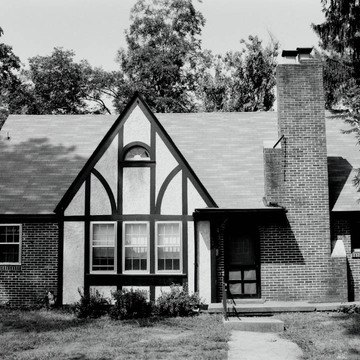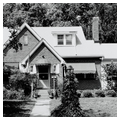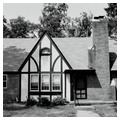Developed as a “strictly high class” enclave for middle management personnel connected with the new industries in Hopewell, Crescent Hills contains forty-four Sears, Roebuck and Company “Honor Bilt” prefabricated houses erected over a ten-year period. Part of its attraction was the financing plans Sears offered, along with the chance to modify or customize to individual preferences. The following mentions houses for which specific models can be identified in Sears catalogs published in the years indicated.
Oakwood Avenue: At 102 Oakwood Avenue is the Oakdale (model 3314, 1925–1937). At 104 Oakwood is the Rochelle (1929–1933) but with a projecting gabled entrance and stucco covering. Number 106 is the Oakdale, but with a screened porch and altered entrance. Sears described what was built at 202 Oakwood Avenue as the “Americanized English.” Number 205 is the Lexington (model 3255, 1921–1933). Number 208 is the Oak Park model, but with a brick exterior and without the side lights flanking the doorway; it appeared in the catalog 1926–1933. Number 209 is the Cambridge model (1926–1929), but with a brick peaked gable; the wing is a later addition. Number 211 is the Lexington again, but with an entrance porch and doorway from the Magnolia model.
Prince George Avenue: Number 102 is the Maplewood model, which appeared in the catalog 1932–1933; a later addition is to the right. Number 104 is the Rochelle, but with a different entrance. Number 106 is the Bellewood model, which appeared in the catalog 1931–1933. Number 107 is the Alhambra model, influenced by the Spanish mission craze. Number 109 is the Rochelle model again, but with a different entrance. Number 200 is the Belmont (1932–1933), but with a brick exterior and a reversed floor plan. Number 201 is the Van Jean model (1928–1929), but with a different doorway and windows. Number 206 is the Hawthorne (1931–1933). Finally, number 210 is the Oak Park.
Crescent Avenue: Number 101 is the Branford model (1937), originally built without the wings shown in the catalog, which were later added. Number 102 ( ST30.1) is the Rochelle, but with a different entrance. Number 104 is the Belmont model, almost identical to 200 Prince George Avenue. Number 106 is the Newbury model (1934–1939), but with a different roof treatment. Number 108 is the Mansfield model (1932–1933), but with different roof treatment. Number 201 is the Lexington, but with added dormers. Number 202 ( ST30.2) is the Colchester (1932–1933), but with added half timbering.
City Point Road: Number 2603 is the original model for Crescent Hills and M. T. Broyhill's home. It is based on the Lexington but with modified window treatment. Number 2705 is the Rochelle model.




